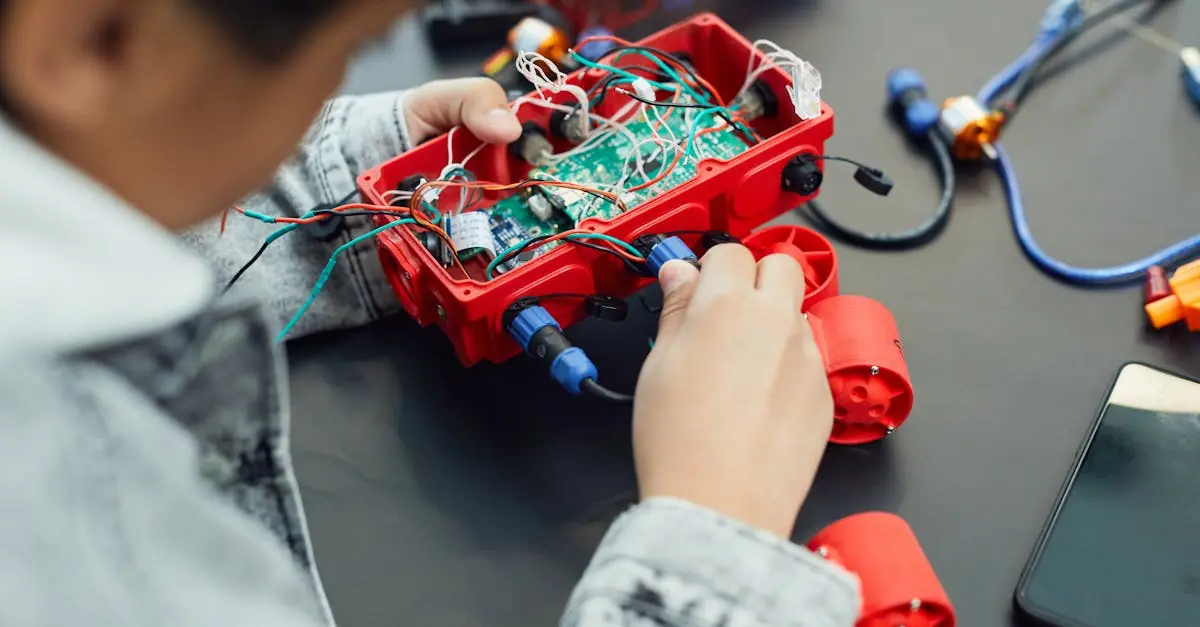Every parent knows the struggle of keeping kids entertained without resorting to endless screen time. Enter DIY projects—where creativity meets chaos in the most delightful way! These hands-on activities not only spark imagination but also turn your living room into a mini art studio. Who needs a museum when you can have a masterpiece right on your fridge?
Table of Contents
ToggleOverview of DIY Projects for Kids
DIY projects for kids offer a wide variety of creative opportunities. Crafting with kids provides both entertainment and skill development. Many projects require minimal materials, making them accessible for families. Through hands-on activities, children enhance problem-solving abilities while expressing their creativity.
Art projects encourage self-expression and imaginative thinking. For instance, painting stones can transform ordinary rocks into unique garden decorations. Building simple birdhouses engages children in construction and design, promoting teamwork and planning.
Educational activities like making a volcano model introduce scientific concepts. Kids learn about chemical reactions while having fun with baking soda and vinegar. Creating homemade playdough facilitates sensory exploration and imaginative play, keeping children engaged for hours.
Using recycled materials fosters environmental awareness. Crafting items such as bottle planters helps kids understand sustainability. Simple paper crafts can decorate living spaces or serve as gifts, encouraging thoughtfulness and creativity.
Parents can easily adapt DIY projects to different age groups. Younger kids may benefit from simpler tasks, while older children can tackle more complex designs. Engaging children in DIY projects cultivates a sense of accomplishment and boosts confidence as they create something from scratch.
DIY projects align with various learning styles. Visual learners excel in scrapbooking or painting. Kinesthetic learners thrive in activities like building or sculpting.
Overall, DIY projects for kids provide enriching experiences that combine fun and education. These activities create opportunities for family bonding, encouraging collaboration and communication.
Benefits of DIY Projects for Kids
DIY projects offer numerous advantages for children. Engaging in hands-on activities encourages creativity and skill development.
Enhancing Creativity
Creativity flourishes through DIY projects. Children visualize, plan, and execute their artistic ideas, which sparks their imagination. Various projects, such as painting, crafting, or building, provide opportunities for self-expression. Completing a unique artwork or design increases their sense of originality. Experimenting with colors, shapes, and materials broadens their creative horizons. Furthermore, showcasing their creations instills pride and confidence. A child’s artistic journey opens pathways for innovative thinking, influencing future problem-solving skills.
Building Problem-Solving Skills
Problem-solving skills develop naturally during DIY projects. Encountering challenges, children must find solutions through trial and error. As they navigate unexpected situations, resourcefulness comes into play. Projects like constructing models or fixing items require logical thinking and planning. Analyzing instructions teaches attention to detail, reinforcing cognitive abilities. Completion of each task boosts self-esteem and encourages persistence. As children adapt their strategies, they gain resilience for future challenges. Each success in DIY activities creates a strong foundation for critical thinking and adaptability in real-life scenarios.
Popular DIY Projects for Kids
DIY projects engage children in fun and educational ways. These activities encourage creativity while developing various skills.
Arts and Crafts
Children enjoy arts and crafts that stimulate their imagination. Painting stones can transform mundane garden areas into colorful displays. Kids might also find joy in creating homemade greeting cards for special occasions. Making friendship bracelets provides a great way to encourage teamwork and sharing. Crafting collages from old magazines can enhance creativity and teach kids about visual storytelling. With simple supplies like paper, glue, and crayons, projects become accessible for all age groups.
Outdoor Projects
Outdoor projects allow kids to explore nature while being active. Building birdhouses fosters collaboration and teaches children about local wildlife. Garden planting introduces responsibility as children nurture seeds into blooming flowers. Creating nature scavenger hunts promotes exploration and learning about the environment. Designing outdoor games with recycled materials encourages physical activity and creativity. Such projects support teamwork and encourage kids to appreciate their surroundings.
Educational Activities
Educational activities blend learning with enjoyment. Constructing volcano models introduces kids to basic science concepts while sparking curiosity. Crafting homemade playdough enhances sensory development through tactile play. Building simple machines, like catapults, provides insight into physics principles. Creating a weather chart helps children track daily conditions, enhancing observation skills. Engaging in math-based art projects, such as geometric designs, reinforces numeracy skills while allowing for artistic expression. Such activities cultivate a love for learning through hands-on experiences.
Safety Tips for DIY Projects
Engaging in DIY projects offers exciting opportunities for kids, but safety remains paramount. Implementing a few key safety tips ensures a fun and secure crafting experience.
Selecting Age-Appropriate Projects
Choosing projects based on children’s ages is critical for their safety. For younger children, opt for simple tasks, like coloring or collages, which require minimal tools or materials. Older kids can handle projects that involve cutting or assembling, such as birdhouses or model volcanoes. Ensure each project matches a child’s skill level, promoting confidence while preventing accidents. Adult supervision enhances safety and provides guidance, making learning enjoyable.
Supervision and Guidance
Supervising children during DIY activities significantly reduces risks. It’s important for adults to stay present when kids use tools or materials that could pose hazards. Inform children about the proper use of all tools, emphasizing safety protocols at every step. Encouraging kids to ask questions fosters an understanding of safe practices. Proactive oversight also allows adults to intervene promptly if an unsafe situation arises.
DIY projects for kids offer a fantastic way to combine creativity and learning. They not only keep children engaged but also help develop essential skills in a fun environment. By using simple materials and encouraging teamwork, these activities foster a sense of accomplishment and boost confidence.
Parents can easily adapt projects to suit different age groups, ensuring everyone can participate. Safety remains a priority, making it crucial to choose age-appropriate tasks and supervise when necessary. Ultimately, embracing DIY projects enriches family time and nurtures a love for exploration and creativity in children.



